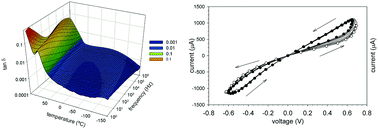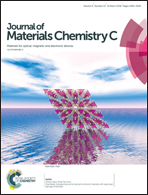Design rules for carbazole derivatized n-alkyl methacrylate polymeric memristors
Abstract
The alternating current (AC) and direct current (DC) electrical response of a number of n-alkyl methacrylate polymers with a charge transporting pendant carbazole ring were studied. The electrical properties of the polymers were studied as a function of the n-alkyl length with n ranging from 2 to 11. The DC current (I)–voltage (V) response of the polymers was characterized by an erratic and bistable response, while their AC I–V response was a pinched hysteresis loop when measured between 1–100 Hz. For polymers with n < 9, their pinched hysteresis loop was characterized by “jump transitions” indicative of bistability, while polymers with n ≥ 9 had a pinched hysteresis loop that was smooth in appearance. Dielectric spectroscopy on the polymers indicated that as the n-alkyl length is increased, the rotation flexibility of the carbazole moiety is enhanced. The n-alkyl methacrylate polymers with a pendant carbazole ring spaced n ≥ 9 exhibited a lower activation energy and temperature for the onset of ring motion and resulted in polymer-based memristors that exhibited electrical characteristics, such as incrementally adjustable conductivity and are potential candidates for mimicking synaptic plasticity.



 Please wait while we load your content...
Please wait while we load your content...